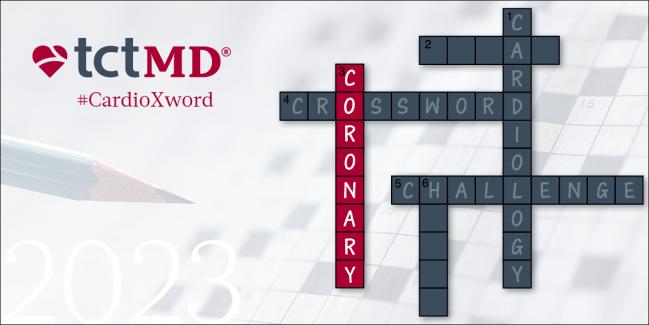Top Coronary Artery Disease News of 2023
ORBITA-2 and Ozempic were big in 2023, but other studies will also help inform clinical practice, says Sanjit Jolly.

Like years past, 2023 saw no shortage of studies aimed at reducing the burden of coronary artery disease, including research that focused on PCI, surgery, statins, and SGLT2 inhibitors in patients with acute MI.
Few trials were more anticipated than the placebo-controlled ORBITA-2 trial, a study that confirmed a role for PCI in patients with stable angina (ORBITA; 39 Down*). Unlike the first ORBITA study, which suggested PCI was no better than placebo when it came to improving exercise capacity at 6 weeks, ORBITA-2 showed that PCI significantly reduced the anginal symptom score, mostly through a reduction in the number of daily angina episodes, when compared with patients undergoing a placebo procedure.
Sanjit Jolly, MD (McMaster University/Population Health Research Institute, Hamilton, Canada), said that ORBITA-2 is an “important proof of concept” study showing that PCI does improve patient symptoms, something clinicians knew intrinsically. That said, he added, ORBITA-2 is unlikely to change how physicians currently practice.
For Jolly, one of the most important clinical trials presented this year was SELECT (34 Down) with semaglutide (Wegovy/Ozempic; Novo Nordisk). That study, presented at the American Heart Association (AHA) meeting in Philadelphia, PA, showed that the glucagon-like peptide-1 receptor agonist (GLP; 29 Down) reduced cardiovascular events—a composite of CV mortality, nonfatal MI, or nonfatal stroke—in overweight or obese patients with preexisting CVD who are not diabetic.
“The Ozempic effect is clearly supported by the evidence,” Jolly told TCTMD. “This is not just a weight-loss drug. This is cardiovascular risk reduction plus weight loss. It’s really, really fascinating, and causing ripples in the stock market, affecting everything from airline stocks to joint replacements. The major challenge is now the availability of Ozempic in different geographies because there are shortages.”
The year also brought some resolution to the debate around revascularization for left main coronary artery disease, an area of controversy since the 5-year EXCEL results led European surgeons to pull their support for the myocardial revascularization guidelines. A task force from the European Society of Cardiology and European Association for Cardio-Thoracic Surgery (ESC/EACTS) recommended that PCI (37 Across) for the treatment of left main CAD in patients at low surgical risk no longer carry a class I recommendation. Instead, PCI should be downgraded to a class IIa recommendation in those with a low-to-intermediate SYTAX score, according to the ESC/EACTS task force.
Earlier this year, investigators announced the launch of ROMA-Women—a first-of-its-kind “sibling” study to the ongoing ROMA (12 Down) trial looking at multiarterial CABG grafting. Later, at the EACTS annual meeting in Vienna, Austria, an all-female panel of cardiac surgeons reminded their colleagues that women fare much worse than men after CABG surgery and emphasized the pressing need to study ways of closing this gap.
Earlier this summer, the American College of Cardiology (ACC) and AHA, along with several other professional bodies, released new guidelines for the management of patients with chronic coronary disease (CHRONIC; 61 Across). The new document provides ample recommendations for treatment, including directions on the use of SGLT2 inhibitors and GLP-1 receptor agonists in select patients, lipid-lowering therapy, antiplatelet therapy, and hypertensive medications, among other recommendations.
When it comes to the benefits of lowering LDL cholesterol, the large, randomized, controlled REPRIEVE (1 Down) trial showed that these benefits also extend to patients with HIV treated with antiretroviral therapy. That National Institutes of Health-funded study, published in the New England Journal of Medicine, showed that pitavastatin cut the risk of major adverse cardiovascular events by 35% in this high-risk but often undertreated population.
Amid the ongoing push to understand the best timing and “completeness” of revascularization, the BIOVASC (42 Across) trial, presented at the ACC 2023 meeting in New Orleans, LA, gave operators some direction in ACS patients. Published simultaneously in the Lancet, the paper showed that an immediate procedure was just as safe as a staged procedures performed over the next few days or weeks.
Also under the revascularization umbrella, Jolly cited two important imaging trials to help inform clinical practice: ILUMIEN IV and RENOVATE-COMPLEX-PCI. In the former, PCI guided by optical coherence tomography (OCT) was compared with angiography alone in high-risk patients with high-risk lesions. While stent placement was better with OCT, and there was a lower risk of stent thrombosis, its use did not lower the risk of target lesion failure at 2 years. Better results were seen in RENOVATE-COMPLEX-PCI, which included patients with true bifurcations, chronic total occlusions, and unprotected left main coronary artery disease. In this study, use of IVUS or OCT did lower the risk of target vessel failure at 2 years compared with angiography alone.
As of December 2023, said Jolly, the messaging around intravascular imaging usage is much more nuanced as a result of the two trials. “In anatomically complex patients, imaging is beneficial, but in fairly straightforward lesions you probably don't need it,” Jolly summarized. “That's fairly valuable because there were really two camps—those who didn't believe in imaging and the others who believed in it like a religion where they considered it unethical not to do a case without it. Really, the evidence would suggest it's somewhere in the middle in terms of case selection and complexity, which I think makes sense clinically.”
Like years past, 2023 also brought several studies looking to find the “sweet spot” (SWEET; 35 Across) when it came to the ideal duration for dual antiplatelet therapy (DAPT). In February, a meta-analysis showed that dropping aspirin after 1-3 months of DAPT was associated with no increase in fatal and ischemic events, but was linked to less bleeding, when compared with continuing standard DAPT. Less is more also appeared to be beneficial in patients with ACS undergoing PCI, although the updated European guidelines only support a short course of DAPT in ACS patients at high bleeding risk.
DAPA-MI (DAPAMI; 47 Across) was another anticipated trial of 2023, but the results were a bit mixed, with the study considered a “soft win” for dapagliflozin (Farxiga; AstraZeneca) when given to acute MI patients with either impaired LV function or Q-wave MI. Cardiometabolic outcomes were improved with treatment, but dapagliflozin did not reduce the risk of cardiovascular death/heart failure hospitalizations, which was the trial’s original primary endpoint.
Investigators also took aim at the optimal transfusion strategy in MINT (59 Across), focused on acute MI patients with anemia. For the primary endpoint, there was only a trend toward reduced MI or mortality at 30 days with the liberal approach, where transfusions were given as needed to maintain hemoglobin 10 mg/dL until discharge, compared with a more restrictive strategy, although this and other endpoints moved in the right direction. Investigators led by Jeffrey Carson, MD (Rutgers Biomedical Health Sciences, New Brunswick, NJ), concluded that, at the very least, there was no harm associated with the liberal strategy.
Finally, Jolly cited the possible emergence of an oral PCSK9 inhibitor as one of the year’s big stories. It’s still early days for the investigational agent, MK-0616, but the introduction of an oral PCSK9 inhibitor that could lower LDL cholesterol would be a big deal—something that could one day be used safely alongside statins to reduce the global burden of cardiovascular disease.
*All of our end of year stories for 2023 contain clues to our Cardiology Crossword Challenge.
Michael O’Riordan is the Managing Editor for TCTMD. He completed his undergraduate degrees at Queen’s University in Kingston, ON, and…
Read Full Bio




Comments